85 Russell Way, Metro Centre, Gateshead, Tyne and Wear, NE11 9YP
When Wetherspoon’s chairman, Tim Martin, opened his first pub in north London, in 1979, he named it Wetherspoons, after a Mr Wetherspoon – his teacher at primary school in New Zealand. The reasoning behind the name is that Mr Wetherspoon was too nice to be running Tim’s particular class and couldn’t control it; Tim thought to himself that, likewise, he couldn’t control his first pub, so considered the name to be appropriate.
Photographs and text about industrialists.
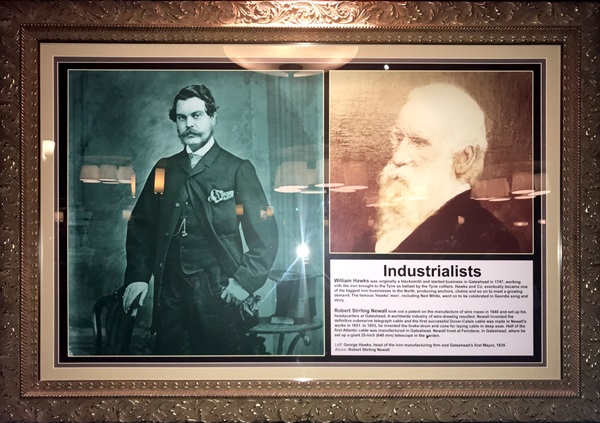
The text reads: William Hawks was originally a blacksmith and started business in Gateshead in 1747, working with the iron brought to the Tyne as ballast by the Tyne colliers. Hawks and Co. eventually became one of the biggest iron businesses in the north, producing anchors, chins and so on to meet a growing demand. The famous ‘Hawks’ men’, including Ned White, went on to be celebrated in Geordie song and story.
Robert Stirling Newall took out a patent on the manufacture of wire ropes in 1840 and set up his headquarters at Gateshead. A worldwide industry of wire-drawing resulted. Newall invented the definitive submarine telegraph cable and the first successful Dover-Calais cable was made in Newall’s works in 1851. In 1853, he invented the brake-drum and cone for laying cable in deep seas. Half of the first Atlantic cable was manufactured in Gateshead. Newall lived in Ferndene, in Gateshead, where he set up a giant 25-inch (640mm) telescope in the garden.
Left: George Hawks, head of the iron manufacturing firm and Gateshead’s first Mayor, 1835
Above: Robert Stirling Newall.
Text and photographs about George Ridley.
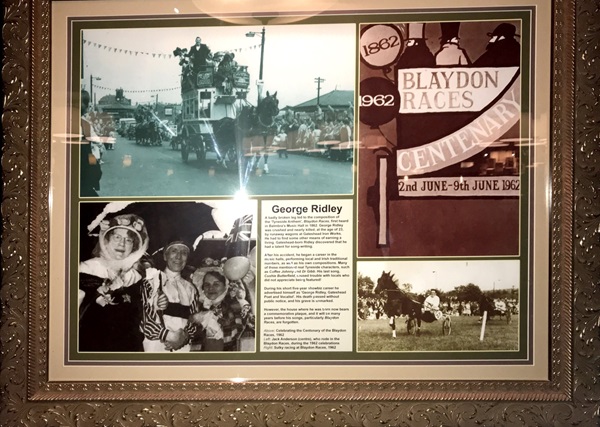
The text reads: A badly broken leg led to the composition of the Tyneside Anthem, Blaydon Races, first heard in Balmbra’s Music Hall in 1862. George Ridley was crushed and nearly killed, at the age of 23, by runaway wagons at Gateshead Iron Works. He had to find some other means of earning a living. Gateshead-born Ridley discovered that he had a talent for song-writing.
After his accident, he began a career in the music halls, performing local and Irish traditional numbers, as well as his own compositions. Many of these mentioned real Tyneside characters, such as Coffee Johnny and Dr Gibb. His last song, Cushie Butterfield, caused trouble with locals who did not appreciate being featured!
During his short five-year showbiz career he advertised himself as ‘George Ridley, Gateshead Poet and Vocalist’. His death passed without public notice, and his grave is unmarked.
However, the house where he was born now bears a commemorative plaque, and it will be many years before his songs, particularly Blaydon Races, are forgotten.
Above: Celebrating the Centenary of the Blaydon Races, 1962
Left: Jack Anderson (centre), who rode in the Blaydon Races, during the 1962 celebrations
Right: Sulky racing at Blaydon Races, 1962.
A print and text about Daniel Defoe.
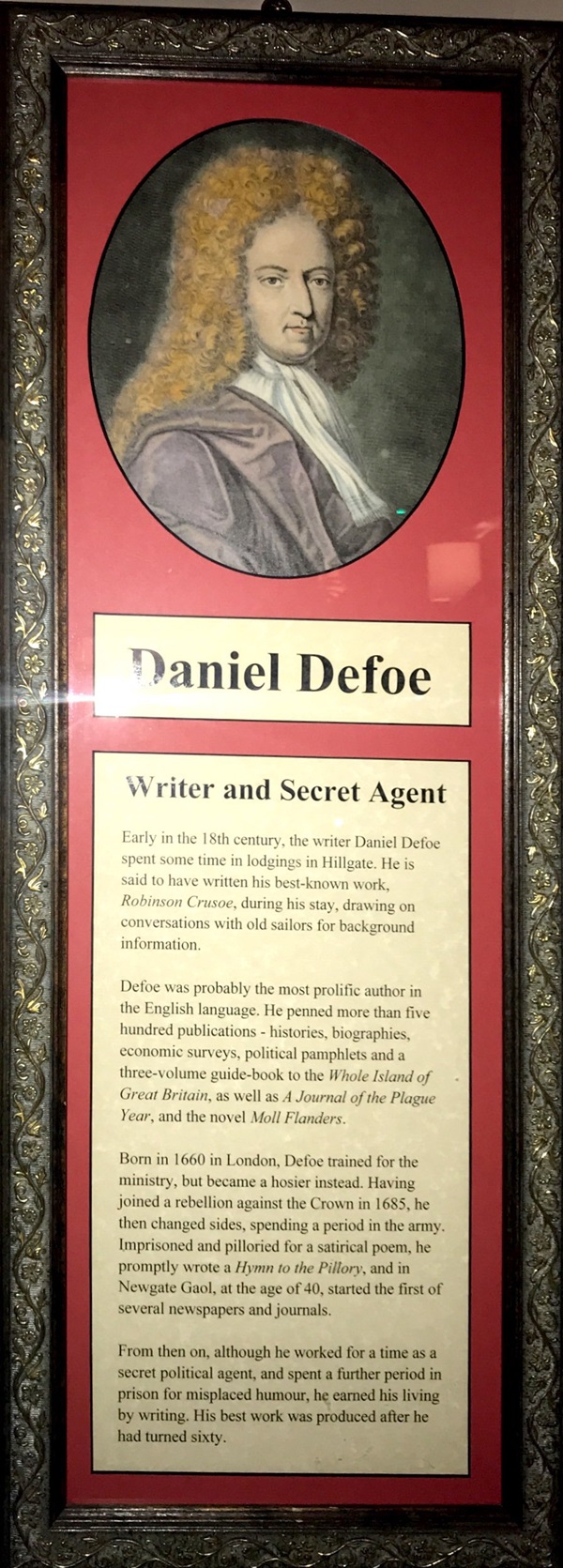
The text reads: Early in the 18th century, the writer Daniel Defoe spent some time in lodgings in Hillgate. He is said to have written his best-known work, Robinson Crusoe during his stay, drawing on conversations with old sailors for background information.
Defoe was probably the most prolific author in the English language. He penned more than five hundred publications – histories, biographies, economic surveys, political pamphlets and a three-volume guide-book to the Whole Island of Great Britain, as well as A Journal of the Plague Year, and the novel Moll Flanders.
Born in 1660 in London, Defoe trained for the ministry, but became a hosier instead. Having joined a rebellion against the Crown in 1685, he then changed sides, spending a period in the army. Imprisoned and pilloried for a satirical poem, he promptly wrote a Hymn to the Pillory, and in Newgate Gaol, at the age of 40, started the first of several newspapers and journals.
From then on, although he worked for a time as a secret political agent, and spent a further period in prison for misplaced humour, he earned his living in writing. His best work was produced after he had turned sixty.
Photographs and text about the history of the cinema.
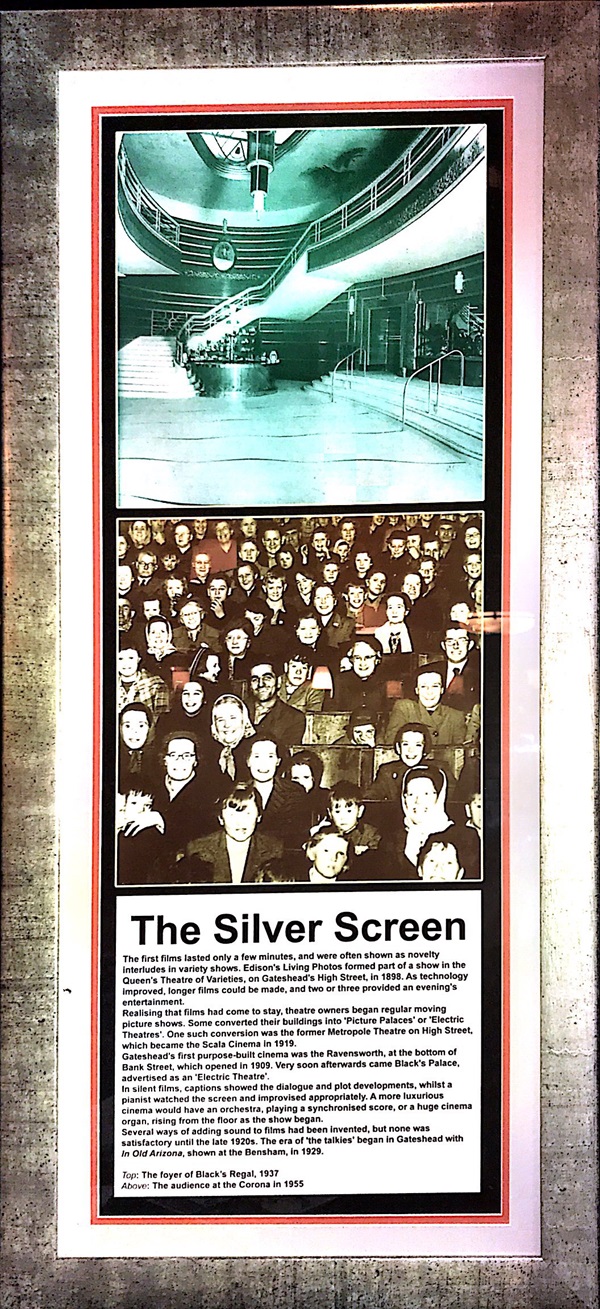
The text reads: The first films lasted only a few minutes, and were often shown as novelty interludes in variety shows. Edison’s Living Photos formed part of a show in the Queen’s Theatre of Varieties, on Gateshead’s High Street, in 1898. As technology improved, longer films could be made, and two or three provided an evening’s entertainment.
Realising that film had come to stay, theatre owners began regular moving picture shows. Some converted their buildings into Picture Palaces or Electric Theatres. One such conversion was the former Metropole Theatre on High Street, which became the Scala Cinema in 1919.
Gateshead’s first purpose-built cinema was the Ravensworth, at the bottom of Bank Street, which opened in 1909. Very soon afterwards came Black’s Palace, advertised as an Electric Theatre.
In silent films, captions showed the dialogue and plot developments, whilst a pianist watched the screen and improvised appropriately. A more luxurious cinema would have an orchestra, playing a synchronised score, or a huge cinema organ, rising from the floor as the show began.
Several ways of adding sound to films had been invented, but none was satisfactory until the 1920s. The era of ‘the talkies’ began in Gateshead with In Old Arizona, shown at the Bensham, in 1929.
Top: The foyer of Black’s Regal, 1937
Above: The audience at the Corona in 1955
A photograph of Quayside, Newcastle-upon-Tyne, c1906.
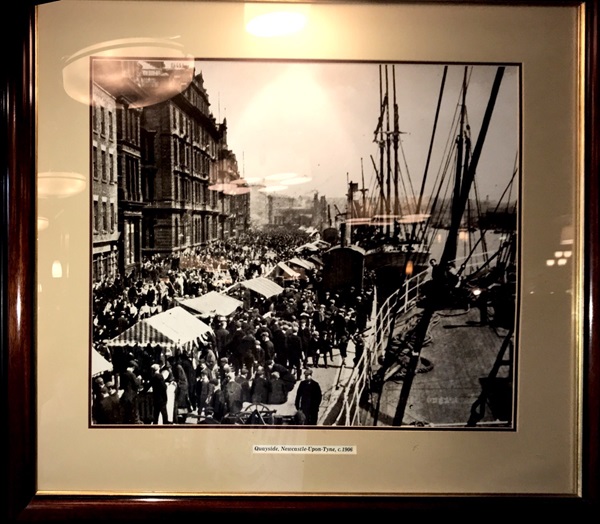
A photograph of Swing Bridge open, Newcastle-upon-Tyne, c1910.
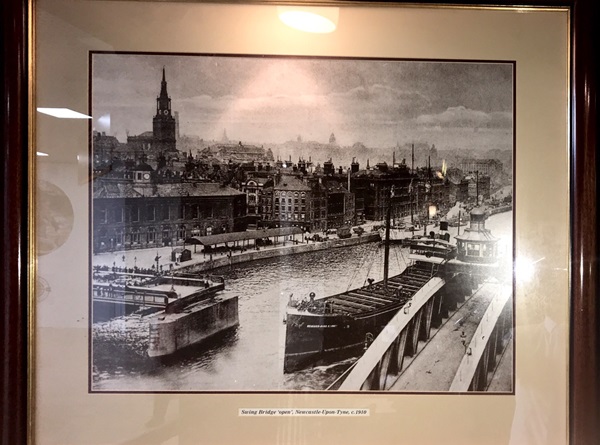
A photograph of a Newcastle steam bus, c1919.
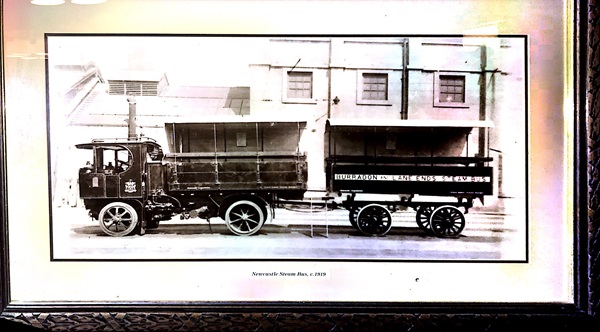
Photographs of colliers loading coal at Dunston Staithes in the late 1930s.
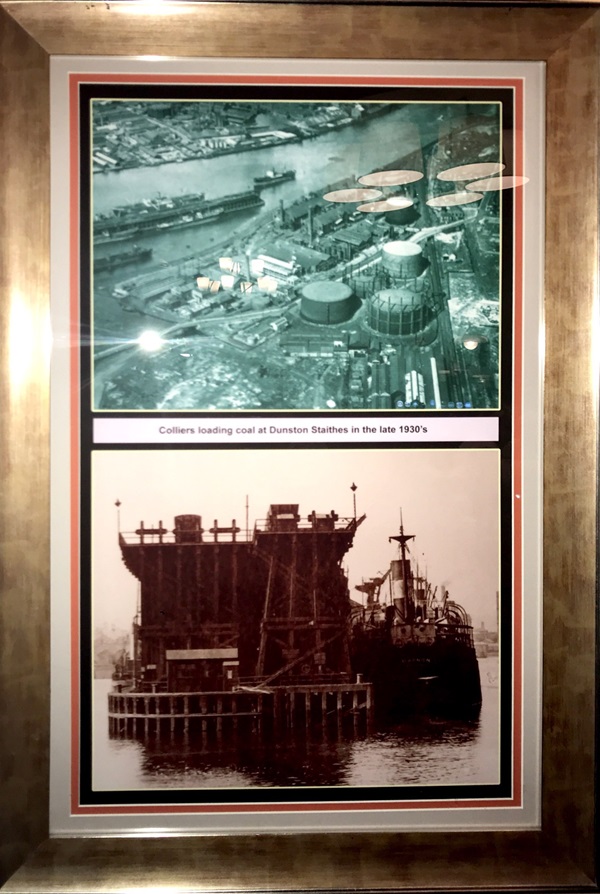
Text about Dunston Staithes
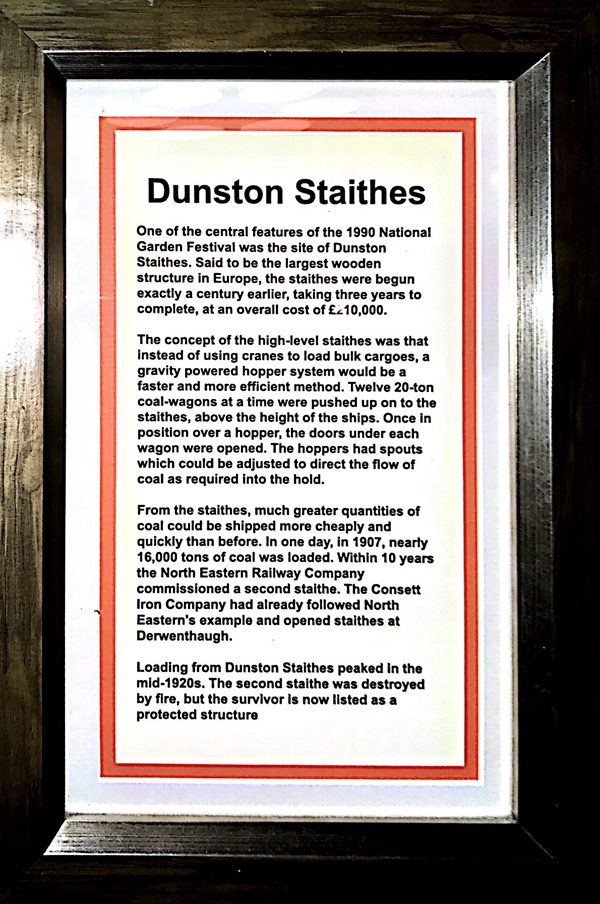
The text reads: One of the central features of the 1990 National Garden Festival was the site of the Dunston Staithes. Said to be the largest wooden structure in Europe, the staithes were begun exactly a century earlier, taking three years to complete, at an overall cost of £210,000.
The concept of the high-level staithes was that instead of using cranes to load bulk cargoes, a gravity powered hopper system would be a faster and more efficient method. Twelve 20-ton coal-wagons at a time were pushed up on to the staithes, above the height of the shops. Once in position over a hopper, the doors under each wagon were opened. The hoppers had spouts which could be adjusted to direct the flow of coal as required into the hold.
From the staithes, much greater quantities of coal could be shipped more cheaply and quickly than before. In one day, in 1907, nearly 16,000 tons of coal was loaded. Within 10 years the North Eastern Railway Company commissioned a second staithe. The Consett Iron Company had already followed North Eastern’s example and opened staithes at Derwenthaugh.
Loading from Dunston Staithes peaked in the mid-1920s. The second staithe was destroyed by fire, but the survivor is now listed as a protected structure.
A print of Richard Trevithick and an illustration of Trevithick’s Gateshead Engine of 1804.
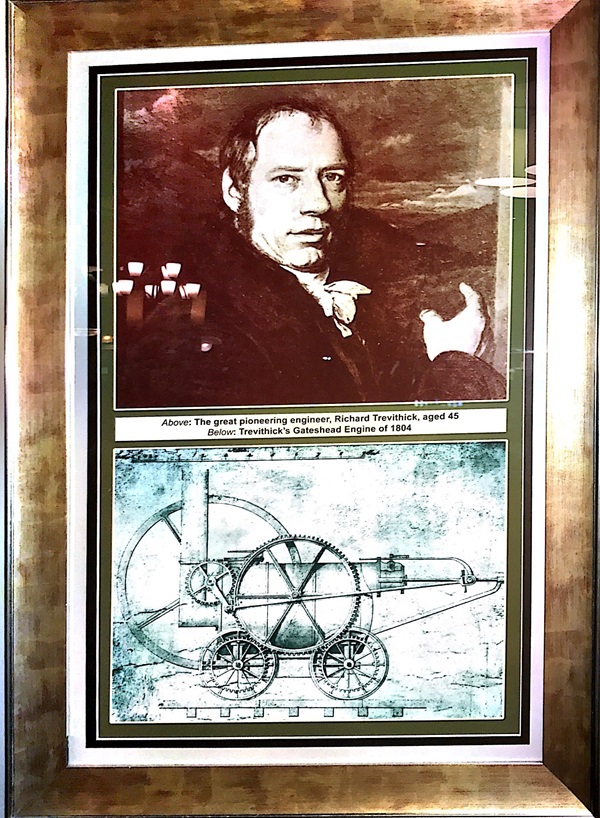
Photographs of the Metro Centre.
.jpg?h=1335&&w=600&la=en&hash=8B60543A5AC1CCC139A70F72AC9EB50B2A9C59AD)
Above: Gateshead’s Mayor, Councillor Bill Ainsworth, and Minister Peter Bottomly, open the Cross Lane interchange linking the Metro Centre with the A69 at Dunston
Centre: The rail connection delivering shoppers to the Metro Centre
Below: The Metro Centre opens in October 1986.
If you have information on the history of this pub, then we’d like you to share it with us. Please e-mail all information to: pubhistories@jdwetherspoon.co.uk